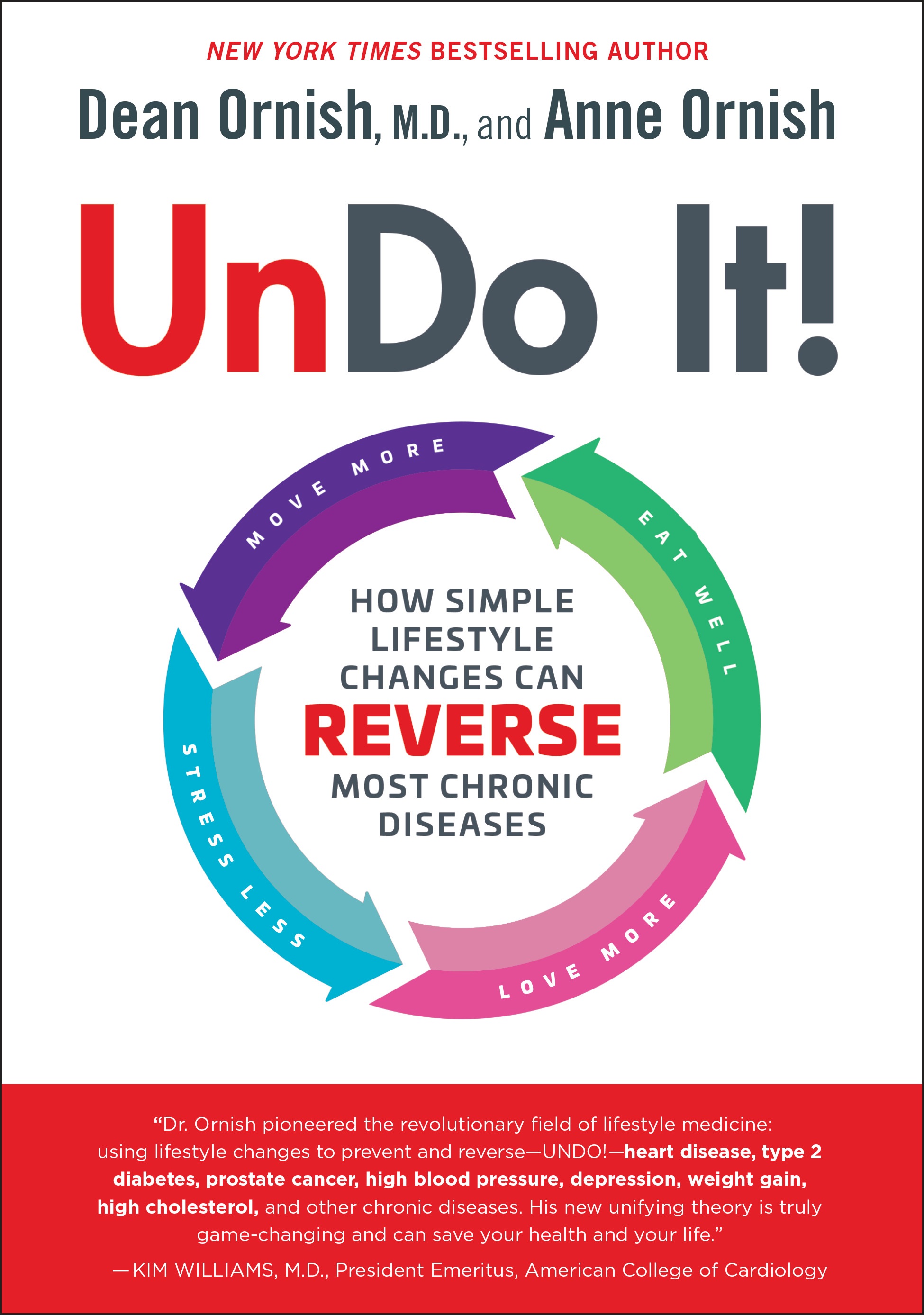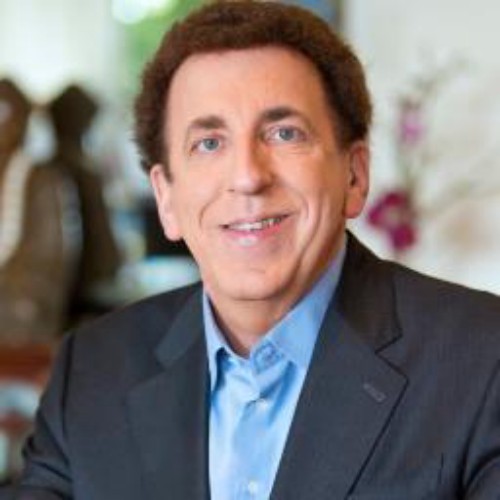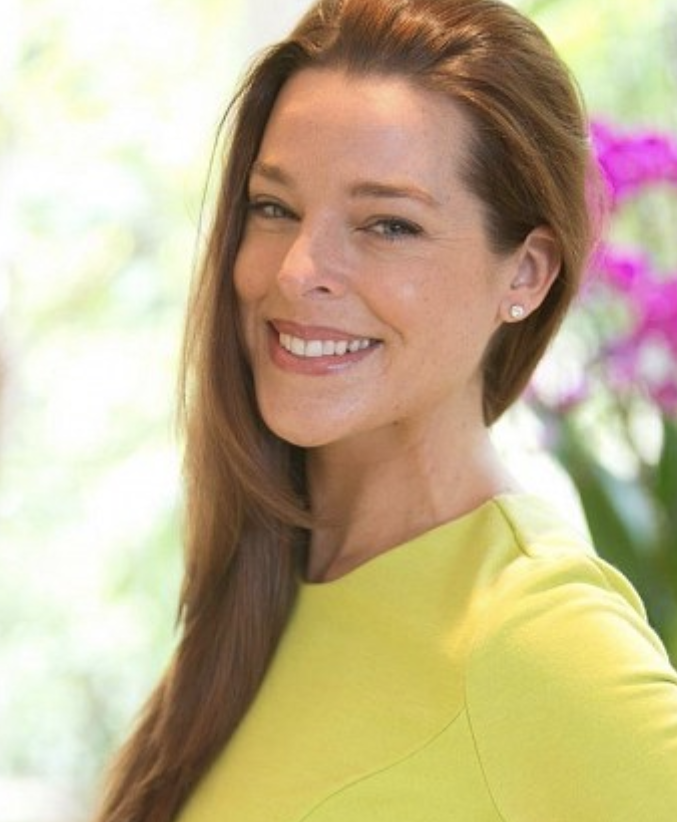Our favorite key on the computer is the undo button. Click!—a fresh start!
We’ve often thought, “Wouldn’t it be nice if there were an undo button for our health as well?”
Well, now there is!
This is the era of lifestyle medicine: that is, using simple yet powerful lifestyle changes to reverse—undo!—the progression of the most common chronic diseases as well as to help prevent them.
For more than four decades, one of us (Dean) has directed a series of randomized, controlled trials and demonstration projects proving, for the first time, that the radically-simple lifestyle medicine program described in this book can often reverse the progression of many of the most common chronic diseases. It can be undertaken in combination with drugs and surgery, or sometimes as an alternative to them.
We continue to be amazed and inspired that the more diseases we study, and the more underlying biological mechanisms we research, the more new reasons and scientific evidence we have to explain why these simple lifestyle changes are so powerful, how transformative and far-ranging their effects can be, and how quickly people can show significant and measurable improvements—often in just a few weeks or even less.
We are excited that our research and the studies of other investigators are proving that many of the most common and debilitating chronic diseases and even much of the damages of aging at a cellular level can often be slowed, stopped, or even reversed by this lifestyle medicine program. These include:
- Reversing even severe coronary heart disease
- Reversing type 2 diabetes
- Reversing, slowing, or stopping the progression of early-stage prostate cancer
- Reversing high blood pressure
- Reversing elevated cholesterol levels
- Reversing obesity
- Reversing some types of early-stage dementia
- Reversing some autoimmune conditions
- Reversing emotional depression and anxiety
Our studies have been published in the leading peer-reviewed medical and scientific journals and presented at the most well-respected physician conferences. No other lifestyle program has this level of scientific evidence on reversing these chronic diseases. This is one reason why a panel of independent experts from U.S. News & World Report rated “The Ornish Diet is #1 for Heart Health” in 2011, 2012, 2013, 2014, 2015, 2016, and 2017.
Awareness is the first step in healing, and science is a powerful tool for raising awareness. Our peer-reviewed research findings provide the credibility to help overcome what is often the biggest obstacle: skepticism that such simple lifestyle changes can have such powerful, far-reaching measurable improvements—and how fast you can feel better. In that spirit, we are including this information not to boast but (hopefully) to inspire and empower, to rise above the noise and misinformation that are so prevalent.
We’ve used high-tech, state-of-the-art scientific measures to prove the power of this low-tech lifestyle medicine intervention. The science may motivate you to get started; the extraordinary benefits you are likely to quickly experience are what make it sustainable.
Our program has four major components, each a healing modality on its own and synergistic when done together:
- A whole foods, plant-based diet (naturally low in animal protein, fat, sugar, and refined carbohydrates and high in flavor)—primarily fruits, vegetables, whole grains, legumes, and soy products in their natural, unprocessed forms. The principles of eating this way are simple and clear.
- Moderate exercise (such as walking and strength training). Do what you enjoy—if you like it, you’ll do it. Chapter 5 shows why and how a little exercise goes a very long way.
- Stress management. Chapter 6 introduces you to techniques (including meditation and gentle yoga) that can enable you to do more and stress less.
- Love, social support and intimacy. People who feel lonely, depressed and isolated are three to ten times more likely to get sick and die prematurely from virtually all causes when compared to those who have strong feelings of love, connection and community. Chapter 7 describes how we can transform isolation into healing and resilience.
In the spirit of keeping it simple, here is the way of eating that we have proven can reverse the progression of so many different chronic illnesses:
- Consume mostly plants (“good carbs” and “good protein”): vegetables, fruits, whole grains, legumes, soy products, and small amounts of nuts and seeds as close as possible in their natural, unprocessed forms.
- What you include in your diet is as important as what you exclude. There are many thousands of protective factors in plant-based foods that have anti-cancer, anti-heart disease, and anti-aging properties as well as being very low in disease-promoting substances.
- Minimize, or even better, eliminate animal protein and replace it with plant-based protein.
- Avoid sugar, white flour, white rice, and other “bad carbs.”
- Consume 3 grams per day of “good fats” (omega-3 fatty acids).
- Reduce intake of total fat, and especially “bad fats” such as trans fats, saturated fats, and partially hydrogenated fats.
- Organic is optimal—foods taste much better, and they are much lower in insecticide residues which can disrupt your hormones.
That’s it! To undo most chronic diseases (paraphrasing Michael Pollan ): Eat real foods. Just plants. Not too much sugar or fat.
You already know that exercise is good for you. What you may not know is just how amazingly beneficial it is, and how even a little exercise goes a very long way.
There are three basic types of exercise we recommend for just about everyone: aerobic exercise (e.g., walking), strength training (e.g., with bands or lifting weights), and stretching.
Even small amounts of exercise make you happier. A 2018 review of 23 studies with 500,000 people ranging in age from adolescents to the very old and covering a broad range of ethnic and socioeconomic groups found that exercise was strongly linked to happiness. Every one of these studies showed a beneficial relationship between being physically active and being happy.
It didn’t take much—just 10 minutes a week of exercise was linked with being happier! And those who worked out only once or twice a week said they felt much happier than those who never exercised. Those who worked out 30 minutes a day showed even greater benefits. Both aerobic exercise and stretching/balancing exercises were effective in improving happiness.
Even a very busy person can find 10 minutes a week to exercise!
Here are five different stress reduction techniques, followed by step by step instruction. Do what works for you and your lifestyle:
1.Gentle Stretching – Think of gentle stretching as ‘healing movements’ that bring you back into the conscious experience of your own body, while helping you listen to signals and symptoms before they become problematic. As your body relaxes, so does your mind. The focus in this technique is on creating a relationship with your body and listening to the information it is offering you about yourself. Benefits include: increased balance and coordination, improved strength and flexibility, increased bone strength, regulated breathing rhythm, improved body awareness.
2. Breathing Techniques –Your breath both reflects and affects your emotions. The way we think and feel affects the way we breathe, and the way we breathe affects the way we think and feel. When we’re stressed, we tend to breathe in a rapid and shallow way. Therefore, one of the easiest and quickest ways to control stress is to consciously breathe slowly and deeply. The practice of consciously guiding the direction, depth and rhythm of your breath can restore, calm and balance the nervous system, increase oxygen circulation in the blood, help increase awareness of internal states, and lower blood pressure and heart rate.
3. Meditation – Meditation is the act of steadying your concentration on one object such as your breath, a word, or a feeling. Meditation allows us to stay centered while observing the natural ups and downs of the mind. The benefits of meditation also include better concentration, a more consistent feeling of calm, clarity and sharpened mind. Those who meditate daily often comment that the things that used to bother them, don’t bother them as much anymore. Regular meditators report that their practice provides them with greater insight and inspiration. One study showed that meditation can change the expression of your genes in only eight weeks—turning on genes that keep you healthy, turning off ones that lead to illness—and long-term meditation caused even more improvements.
4. Guided Imagery — Our bodies respond to mental images as though we are really experiencing what we are imagining–for better and for worse. Thus, using your imagination to invoke positive imagery can help support healing outcomes. Amazingly, developing positive imagery can induce positive mental and physical states that can re-pattern feelings, thoughts and behaviors that lead to healing. In contrast, when we worry and imagine an awful outcome, this can also become self-fulfilling.
5. Deep Relaxation — Deep relaxation is one of the most healing practices of all. When you are able to deeply relax–a learned, conscious, and progressive letting go of tension and stress—you allow and support the body’s natural healing process. You will find that you are able to rest and restore even more deeply than during sleep.
Whom we choose not to be with brings as much meaning to our lives as who we choose to be with. For this reason, being in a committed, monogamous relationship can, paradoxically, allow more freedom and pleasure at its best:
- The more committed we are, the more we trust;
- The more we trust, the safer we feel;
- The safer we feel, the more emotionally vulnerable we are able to be with each other;
- The more vulnerable we feel, the more we can open our hearts, wider and wider;
- The more open our hearts become, the more intimacy we experience;
- The more intimate we are, the more healing, joyful, erotic, and pleasurable it becomes;
- The more healing, joyful, erotic, and pleasurable it becomes, the more meaningful and liberating it is. In this way, we make our relationships, and our lives, sacred—i.e., the most special, the most ecstatic.

From UNDO IT! by Dean Ornish, M.D., and Anne Ornish, published by Ballantine Books, an imprint of Random House, a division of Penguin Random House, LLC. Copyright © 2019 by Dean Ornish, M.D., LLC
Follow us here and subscribe here for all the latest news on how you can keep Thriving.
Stay up to date or catch-up on all our podcasts with Arianna Huffington here.



